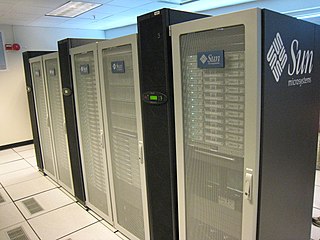Related Research Articles

HP-UX is Hewlett Packard Enterprise's proprietary implementation of the Unix operating system, based on Unix System V and first released in 1984. Current versions support HPE Integrity Servers, based on Intel's Itanium architecture.

A Beowulf cluster is a computer cluster of what are normally identical, commodity-grade computers networked into a small local area network with libraries and programs installed which allow processing to be shared among them. The result is a high-performance parallel computing cluster from inexpensive personal computer hardware.

InfiniBand (IB) is a computer networking communications standard used in high-performance computing that features very high throughput and very low latency. It is used for data interconnect both among and within computers. InfiniBand is also used as either a direct or switched interconnect between servers and storage systems, as well as an interconnect between storage systems. It is designed to be scalable and uses a switched fabric network topology. Between 2014 and June 2016, it was the most commonly used interconnect in the TOP500 list of supercomputers.

DTrace is a comprehensive dynamic tracing framework originally created by Sun Microsystems for troubleshooting kernel and application problems on production systems in real time. Originally developed for Solaris, it has since been released under the free Common Development and Distribution License (CDDL) in OpenSolaris and its descendant illumos, and has been ported to several other Unix-like systems.
The VERITAS File System is an extent-based file system. It was originally developed by VERITAS Software. Through an OEM agreement, VxFS is used as the primary filesystem of the HP-UX operating system. With on-line defragmentation and resize support turned on via license, it is known as OnlineJFS. It is also supported on AIX, Linux, Solaris, OpenSolaris, SINIX/Reliant UNIX, UnixWare and SCO OpenServer. VxFS was originally developed for AT&T's Unix System Laboratories. VxFS is packaged as a part of the Veritas Storage Foundation.
Veritas Storage Foundation (VSF), previously known as Veritas Foundation Suite, is a computer software product made by Veritas Software that combines Veritas Volume Manager (VxVM) and Veritas File System (VxFS) to provide online-storage management. Symantec Corporation developed and maintained VSF until January 29, 2016, at which point Veritas and Symantec separated. The latest product version, 7.0, was re-branded as "Veritas InfoScale 7.0".

Oracle Solaris Cluster is a high-availability cluster software product for Solaris, originally created by Sun Microsystems, which was acquired by Oracle Corporation in 2010. It is used to improve the availability of software services such as databases, file sharing on a network, electronic commerce websites, or other applications. Sun Cluster operates by having redundant computers or nodes where one or more computers continue to provide service if another fails. Nodes may be located in the same data center or on different continents.
Veritas Backup Exec is a data protection software product designed for customers with mixed physical and virtual environments, and who are moving to public cloud services. Supported platforms include VMware and Hyper-V virtualization, Windows and Linux operating systems, Amazon S3, Microsoft Azure and Google Cloud Storage, among others. All management and configuration operations are performed with a single user interface. Backup Exec also provides integrated deduplication, replication, and disaster recovery capabilities and helps to manage multiple backup servers or multi-drive tape loaders.
In database computing, Oracle Real Application Clusters (RAC) — an option for the Oracle Database software produced by Oracle Corporation and introduced in 2001 with Oracle9i — provides software for clustering and high availability in Oracle database environments. Oracle Corporation includes RAC with the Enterprise Edition, provided the nodes are clustered using Oracle Clusterware.

Sun Microsystems' UltraSPARC T2 microprocessor is a multithreading, multi-core CPU. It is a member of the SPARC family, and the successor to the UltraSPARC T1. The chip is sometimes referred to by its codename, Niagara 2. Sun started selling servers with the T2 processor in October 2007.
Solaris Containers is an implementation of operating system-level virtualization technology for x86 and SPARC systems, first released publicly in February 2004 in build 51 beta of Solaris 10, and subsequently in the first full release of Solaris 10, 2005. It is present in illumos distributions, such as OpenIndiana, SmartOS, Tribblix and OmniOS, as well as in the official Oracle Solaris 11 release.

Oracle Linux is a Linux distribution packaged and freely distributed by Oracle, available partially under the GNU General Public License since late 2006. It is compiled from Red Hat Enterprise Linux (RHEL) source code, replacing Red Hat branding with Oracle's. It is also used by Oracle Cloud and Oracle Engineered Systems such as Oracle Exadata and others.

A computer cluster is a set of computers that work together so that they can be viewed as a single system. Unlike grid computers, computer clusters have each node set to perform the same task, controlled and scheduled by software. The newest manifestation of cluster computing is cloud computing.
On March 15, 2011, Symantec released Symantec Operations Readiness Tools (SORT), an updated version of Veritas Operations Services (VOS).
Exalogic is a computer appliance made by Oracle Corporation, commercially available since 2010. It is a cluster of x86-64-servers running Oracle Linux or Solaris preinstalled.
Linux on IBM Z or Linux on zSystems is the collective term for the Linux operating system compiled to run on IBM mainframes, especially IBM Z / IBM zSystems and IBM LinuxONE servers. Similar terms which imply the same meaning are Linux/390, Linux/390x, etc. The three Linux distributions certified for usage on the IBM Z hardware platform are Red Hat Enterprise Linux, SUSE Linux Enterprise Server, and Ubuntu.
Enduro/X is an open-source middleware platform for distributed transaction processing. It is built on proven APIs such as X/Open group's XATMI and XA. The platform is designed for building real-time microservices based applications with a clusterization option. Enduro/X functions as an extended drop-in replacement for Oracle Tuxedo. The platform uses in-memory POSIX Kernel queues which insures high interprocess communication throughput.
Veritas Technologies LLC. is an American international data management company headquartered in Santa Clara, California. The company has its origins in Tolerant Systems, founded in 1983 and later renamed Veritas Software. It specializes in storage management software including the first commercial journaling file system, VxFS, VxVM, VCS, the personal/small office backup software Backup Exec and the enterprise backup software, NetBackup. Veritas Record Now was an early CD recording software.
ONTAP or Data ONTAP or Clustered Data ONTAP (cDOT) or Data ONTAP 7-Mode is NetApp's proprietary operating system used in storage disk arrays such as NetApp FAS and AFF, ONTAP Select, and Cloud Volumes ONTAP. With the release of version 9.0, NetApp decided to simplify the Data ONTAP name and removed the word "Data" from it, removed the 7-Mode image, therefore, ONTAP 9 is the successor of Clustered Data ONTAP 8.
References
- ↑ "Veritas InfoScale™ What's New Guide". Veritas. Archived from the original on 2017-03-30. Retrieved 2021-11-08.
- ↑ "Veritas InfoScale™ What's New Guide 7.0 Windows". Veritas. Retrieved 2021-11-08.
- 1 2 Symantec. Veritas Cluster Server 5.0 User's Guide (Solaris) (PDF). Symantec. pp. 331–360.[ dead link ]
- Pfister, Greg (1998). In Search of Clusters. Prentice Hall. ISBN 0-13-899709-8.
- Marcus, Evan; Hal Stern (2000). Blueprints for High Availability1: Designing Resilient Distributed Systems. John Wiley & Sons. ISBN 0-471-35601-8.